Spanish Fencing Notation Part 4 – The Position of the Hand
(10/1/2009)
Hand Positions
In the Italian tradition the hand positions are notated as first, second, third and fourth. While this is concise, it doesn’t provide any information that guides the student to the correct position without additional explanation. When grasping a sword, we can discuss the same hand positions by the orientation of the fingernails. By using the fingernails as a reference, the Spanish system achieves a very simple notation for the position of the hand in plain language.
Fingernails Down (uñas abajo) – The edges are in the horizontal plane with the true edge on the outside line and the fingernails facing downward. This is the same as Italian Second. Carranza considers this position one of the two possible extremes that will be weaker than the moderate halfway point between this position and fingernails up.
——————————
Fingernails Inside or On Edge (uñas adentro or de filo) – The edges are in the vertical plane with the true edge low and the fingernails facing toward the inside line. This is the same as Italian Third. Carranza considers this the best position and it is halfway between the two extremes of fingernails up and fingernails down.
——————————
Fingernails Up (uñas arriba) – The edges are in the horizontal plane with the true edge on the inside line and the fingernails facing upward. This is the same as Italian Fourth. Carranza considers this position one of the two possible extremes that will be weaker than the moderate halfway point between this position and fingernails down.
—————————–
Fingernails Outside (uñas afuera) – The edges are in the vertical plane with the true edge high and the fingernails facing toward the outside line. This is the same as Italian First and while it is mentioned, using this hand position is so unusual that Pacheco and Carranza typically speak only of the other three.
Hand Position in the Spanish Stance
The primary sources indicate fingernails inside or sword on edge is the hand position used when assuming the stance.
Carranza’s Description of the Position of the Sword Arm from The Philosophy of Arms… p. 155-156 (1569, pub. 1582):
| “And the best of all these positions is as the arm originates because in it the nerves are more relaxed and the action of the Muscles—which are (as it is said) the instruments of the voluntary movement—quicker. In this position the strength endures longer, and since it is the middle (according to necessity) one passes easily to the extremes. For these reasons and others that come from these, the position on Edge is stronger and better than the one with fingernails down or up. Between the extremes there is advantage, like in those extremes that the virtues have (as we will mention in its place), because the extreme that the Fingernails Up arm makes is not as strong as the position of Fingernails Down. Thus, of the two, Fingernails Down is the most noble because it strains the Nerves less to maintain the strength, because even though the arm does not move (seemingly) the Muscles are working inside that maintain it in that position….” |
~Translated by Mary Curtis
To explain this passage, hang your swordarm normally at your side and then reach forward as if shaking hands. A natural extension places the weapon arm as it “originates” with the fingernails facing the inside. If you extend your arm with the fingernails in you are halfway between the extremes of fingernails down and fingernails up which allows you to engage with your true edge quickly as needed.
You should also note that the text explicitly indicates fingernails inside is stronger than fingernails up and fingernails down. Coming into guard fingernails up or fingernails down contradicts the author which is our primary source. Carranza provides us with a ranking of the hand positions with fingernails in as the best and fingernails up as the least strong or worst of the three.
- Fingernails in or sword on edge (Best)
- Fingernails down (better than fingernails up)
- Fingernails up (worst and least strong)
(Carranza does not discuss fingernails outside in this passage and by its omission we might assume it would qualify as the least useful position.)
Pacheco’s Image of the Stance from The Book of the Greatness of the Sword p.39 (1600)
Pacheco again in New Science p.30 (1632)
| “The right angle is seen with the body being straight, and over the right angle or over the parallel lines, and he extends the arm straight as it originates from the body, without lowering it nor raising it.” |
~Translated by Mary Curtis
Ettenhard’s Description of the Position of the Sword Arm from Compendium of the Foundations… p.13 (1675)
| The first thing that one should deal with is the way to form the Angles, with the application of the Geometric measurements; and beginning with this, I say: That the Swordsman forms the Right Angle when he stands with the body straight and perpendicular; as he naturally falls over both feet, leaving a half foot distance between one heel and the other; and then holding out the arm and Sword straightly, like it originates from the body,… |
~Translated by Mary Curtis
Over 100 years later, we see that Ettenhard comes very close to quoting Carranza in his description of how to assume the stance with the arm extended “like it originates from the body“. When comparing the text to the relevant image in Treatise 2, Chapter 1, we see Ettenhard’s fencer with the hand fingernails inside which further confirms the interpretation.
Brea’s Images in Universal Principles… Ch12.L7 (1805)
In 1805, Manuel Antonio de Brea shows the stance in his book again with the hand fingernails to the inside.
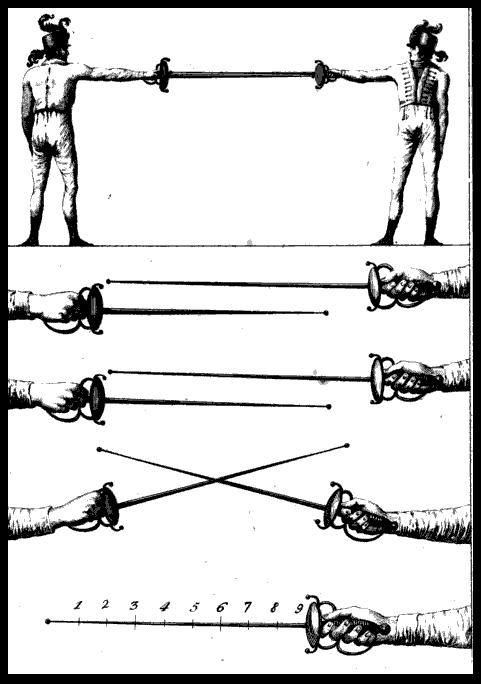
Brea shows the hand position in the stance with the fingernails facing inward for this demonstration of the Measure of Proportion and the Degrees of Strength in the weapon.
You can view Brea’s Universal Principles and General Rules… online with Google Books here:
Thibault’s Academy of the Sword Ch43 – Plate 12 (1630)
Even Girard Thibault, who is arguably outside the mainstream Spanish canon, demonstrates his stance with the hand fingernails in. Because of the peculiarity of his grip, Thibault’s cross is aligned in the horizontal plane, but the hand again follows Carranza’s advice extending as the arm originates with the fingernails facing the inside line.
Wikipedia Article with two images of Thibault’s intricate plates
Conclusion
The repeated examples in both the texts and original images provides compelling evidence that assuming the stance with the weapon hand in a position other than fingernails inside would be a significant deviation from the tradition. While the hand position may naturally change in the course of an encounter by starting between the two extremes of fingernails up and fingernails down, the Spanish fencer is able to quickly change the position of the hand to align the true edge as needed while fencing.


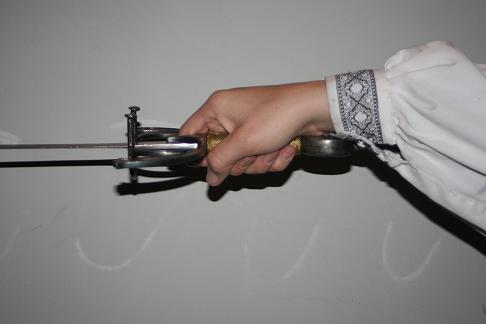
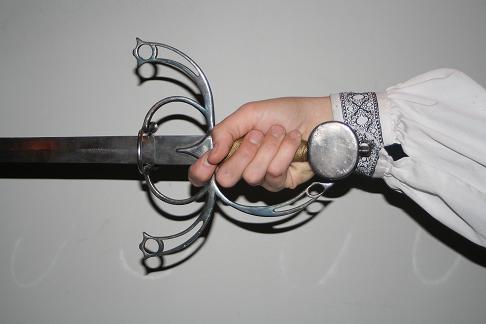
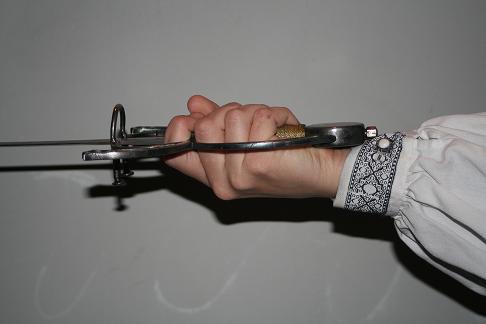
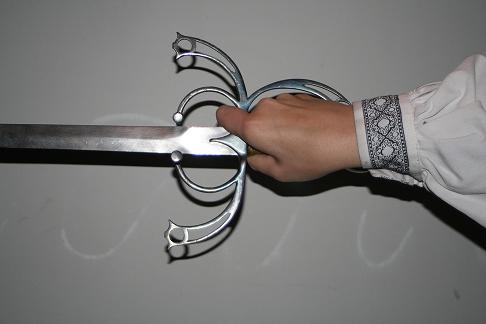
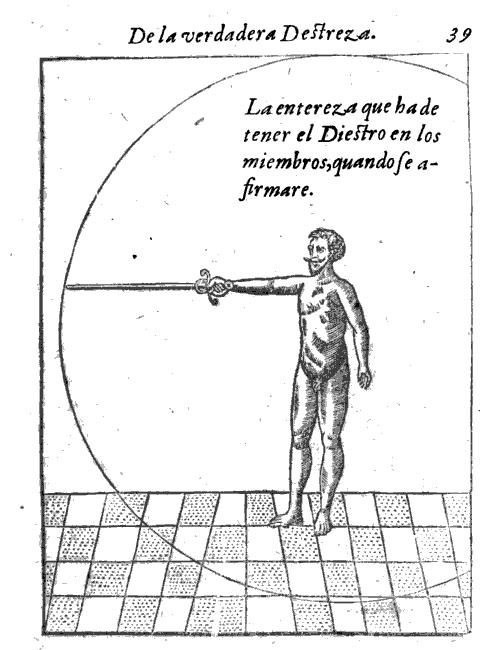
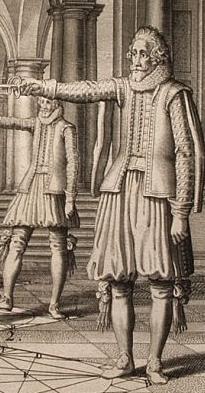
[…] a great set of articles up over at A Midsummer Night’s Blog on the Spanish fencing style. Check it […]
By Spanish fencing at A Midsummer Night’s Blog | Elizabethan Mafia on October 2, 2009 8:26 pm
Is there a purpose behind your choice to refer to Pacheco as Pacheco instead of Narváez since you refer to Carranza as Carranza instead of Sánchez? It isn’t important, but it struck me as odd so I thought I’d ask.
Thanks.
By Andrew Telesca on October 3, 2009 12:56 am
Hola Andrew,
(This is Puck w/ Mary leaning over his shoulder as he types.)
If you have a copy of SPADA 2 you can read an explanation on p.73 in the first footnote.
😉
Seriously, it is a good question. The use of final name as the key surname is an English custom which does not reflect the structure of Spanish surnames. Calling Pacheco by ‘Narvaez’ is an unusual exception more common in America I expect.
Carranza’s name is listed as Jeronimo de Carranza in his treatise and he is typically referred to as ‘Carranza’ in Spanish literature or ‘Sanchez de Carranza’.
Don Luis Pacheco de Narvaez is typically referred to as ‘Pacheco’ in Spanish literature. It’s important as an English-speaking researcher to know this because Pacheco’s books are listed under ‘Pacheco ‘ in most collections and not ‘Narvaez’. Also, when searching for Carranza you should search under both surnames (‘Sanchez’ and ‘Carranza’) because there are variations.
As a fencer, you should know that when Pacheco began to distance himself from Carranza’s teachings two competing schools developed called the ‘Carrancistas’ and the ‘Pachequistas’. This distinction between these two groups is also a compelling reason to identify each author as we have done here.
~P & M
By puck on October 3, 2009 1:47 am
As Puck said, in Spain we have got two surnames. First one is the first father’s surname, and second one is the first surname of the mother (they don’t change it when get married).
Sometimes, when the first surename is very common (Sánchez, Fernández, Hernández, González…) we use the second one. But it’s not something we do allways. Just sometimes.
There are many examples, like Rodríguez Zapatero (we call him Zapatero), Pedro Martínez de la Rosa (everybody calls him De la Rosa)…
By Javier on October 4, 2009 1:37 pm
[…] LINK TO ARTICLE 4 […]
By Spanish Fencing Notation Part 5 - Strength of the Weapon | A Midsummer Night’s Blog on November 3, 2009 6:52 pm
Not entirely sure Thibault’s grip is very comparable given the context here as the hand position on the hilt is completely different. The grip is with the index finger over the cross on one side and the pad of the thumb on top of the cross on the other. This basically places the fingers underneath the grip witht he fingernails ending up about 45 degrees around to the inside and the back of the hand on top of the grip and about 45 degrees to the outside. His hand position in this straight arm posture has two positions either with the quillions horizontal or with the quillions turned 45 degree down on the inside. Just nitpicking though, not sure it actually makes a difference to your article.
It should also be noted that Thibault uses tow other positions of the arm. Curved arm, which I won’t go into. And, Bent arm, which uses the standard grip with the thumb on the other side of the quillion. We also sometimes refer to the bent arm grip as the cutting grip. Transitions between the two modes of gripping the sword is a hallmark of Thibault’s system.
If you need more images from Thibault’s tretise let me know, I have high resolution scans of the plates available that things can be taken from.
By Jeff Richardson on November 9, 2009 10:32 pm
All that said, when Thibault tranistions to the the Bent arm grip and the thumb drops around, his standard hand position does indeed become identical with the quilions vertical and the fingernails in.
By Jeff Richardson on November 9, 2009 10:38 pm